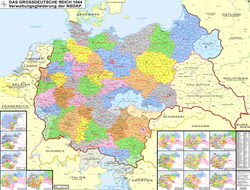Gau Mecklenburg
| Gau Mecklenburg | |||||
| Gau of Nazi Germany | |||||
|
|||||
|
Flag |
|||||
| Capital | Schwerin | ||||
| Gauleiter | |||||
| • | 1926–1945 | Friedrich Hildebrandt | |||
| History | |||||
| • | 1926 | ||||
| • | Disestablishment | 8 May 1945 | |||
| Today part of |
|
||||
Flag
The Gau Mecklenburg, named Gau Mecklenburg-Lübeck until 1937, was an administrative division of Nazi Germany from 1933 to 1945 in the Free State of Mecklenburg-Strelitz and Free State of Mecklenburg-Schwerin. Before that, from 1926 to 1933, it was the regional subdivision of the Nazi Party in that area.
The Nazi Gau (plural Gaue) system was originally established in a party conference on 22 May 1926, in order to improve administration of the party structure. From 1933 onwards, after the Nazi seizure of power, the Gaue increasingly replaced the German states as administrative subdivisions in Germany.
At the head of each Gau stood a Gauleiter, a position which became increasingly more powerful, especially after the outbreak of the Second World War, with little interference from above. Local Gauleiter often held government positions as well as party ones and were in charge of, among other things, propaganda and surveillance and, from September 1944 onward, the Volkssturm and the defense of the Gau.
The position of Gauleiter in Mecklenburg was held by Friedrich Hildebrandt throughout the history of the Gau, interrupted only by an eight-month suspension in 1930–31. Hildebrandt was sentenced to death by a military tribunal and executed for war crimes in 1948.
...
Wikipedia


